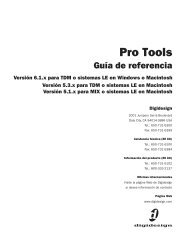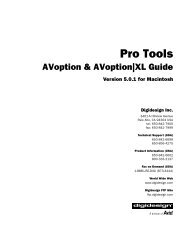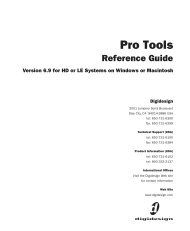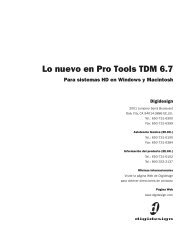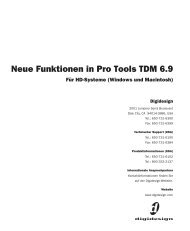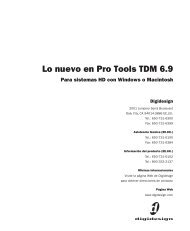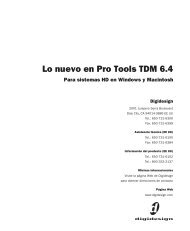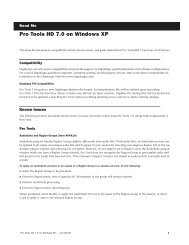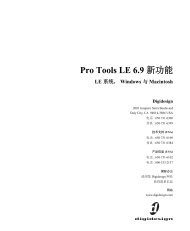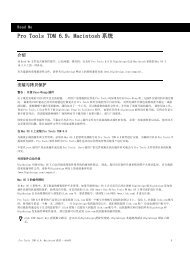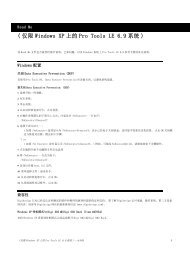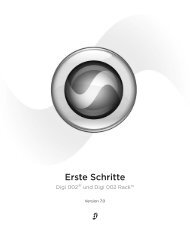5.1 DigiRack Plug-Ins Guide - Digidesign Support Archives
5.1 DigiRack Plug-Ins Guide - Digidesign Support Archives
5.1 DigiRack Plug-Ins Guide - Digidesign Support Archives
Create successful ePaper yourself
Turn your PDF publications into a flip-book with our unique Google optimized e-Paper software.
12<br />
Key Input Filters<br />
Some plug-ins feature key high-pass and lowpass<br />
filters. These controls allow you to define a<br />
specific frequency range in the key input signal<br />
with which to trigger the plug-in effect. A common<br />
production technique is to use these controls<br />
to filter a drum track so that only specific<br />
high frequencies (a hi-hat, for example) or low<br />
frequencies (a tom or a kick, for example) trigger<br />
the effect.<br />
Choosing a key input<br />
To use a key input for side chain processing:<br />
1 From the Key Input menu, choose the input/bus<br />
carrying the audio you want to use to<br />
trigger the plug-in.<br />
2 Click External Key to activate side chain processing.<br />
3 To hear the audio source you have selected to<br />
control side chain input, click Key Listen.<br />
4 To filter the key input so that only specific frequencies<br />
trigger the plug-in, use the Key HPF<br />
and Key LPF controls (if available) to select the<br />
desired frequency range.<br />
5 Begin playback. The plug-in uses the input/bus<br />
that you chose as a key input to trigger<br />
its effect.<br />
<strong>DigiRack</strong> <strong>Plug</strong>-<strong>Ins</strong> <strong>Guide</strong><br />
6 Adjust the plug-in’s Threshold parameter (if<br />
available) to fine tune key input triggering.<br />
7 Adjust other parameters to achieve the desired<br />
effect.<br />
Automating <strong>Plug</strong>-<strong>Ins</strong><br />
You can automate changes to plug-in parameters.<br />
Since Pro Tools creates a separate playlist<br />
for each plug-in parameter that you automate,<br />
you can later edit and modify each automated<br />
parameter individually. This allows you to build<br />
up complex automation in stages.<br />
To create automation for a stereo plug-in<br />
with separate controls for each channel,<br />
(such as Mod Delay), record the automation<br />
for one channel then copy and paste it to the<br />
other channel.<br />
To enable automation:<br />
1 Open the <strong>Plug</strong>-In window for the plug-in you<br />
want to automate.<br />
2 Click the Automation button, choose the parameters<br />
to automate, and click Add, then OK.<br />
<strong>Plug</strong>-In automation dialog<br />
– or –



